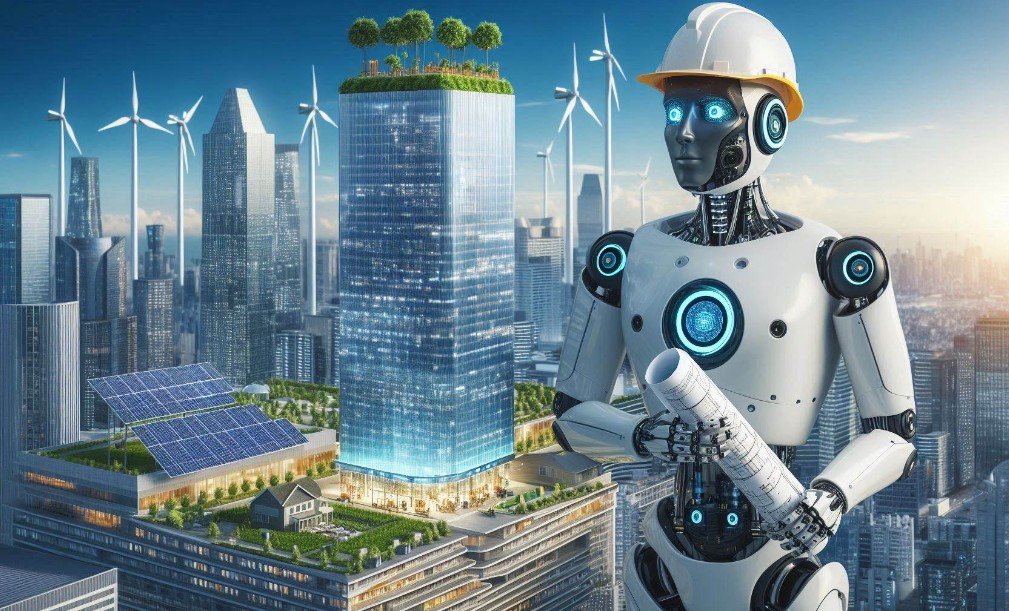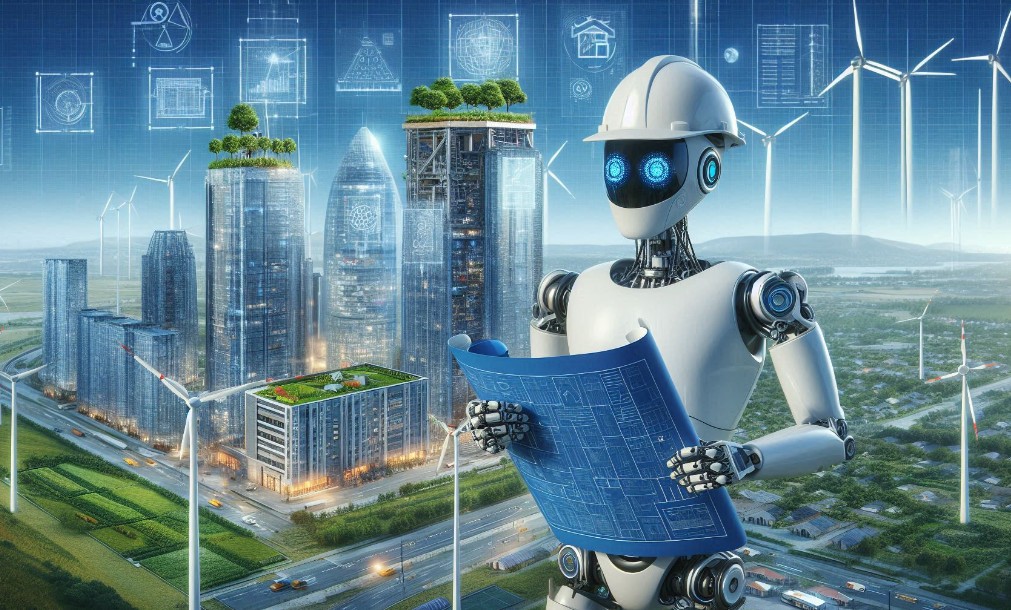In recent years, there has been a significant advancement in the field of Artificial Intelligence (AI) and Augmented Reality (AR). These technologies have become increasingly popular and have the potential to enhance virtual experiences in various fields such as gaming, education, healthcare, and...
AI Revolutionizes Sustainable Architecture Design

In an era where environmental sustainability has become a global priority, the architecture and construction industries are increasingly turning to innovative solutions to reduce their ecological footprints. One of the most promising advancements in this domain is the integration of artificial intelligence (AI) systems. These cutting-edge technologies are revolutionizing the way architects design eco-friendly buildings, offering unprecedented precision and efficiency.
AI-driven tools are now capable of analyzing vast amounts of data related to energy consumption, material properties, and environmental impact. By leveraging this data, architects can make more informed decisions that optimize both the design and functionality of buildings. This not only helps in reducing waste and conserving resources but also ensures that the structures are better suited to their natural surroundings.
Moreover, the use of AI in architectural design goes beyond mere optimization. Machine learning algorithms can predict potential environmental challenges and suggest innovative solutions to mitigate them. For instance, AI can recommend the best orientations for natural light, propose the use of renewable energy sources, and identify materials that have minimal environmental impact. This proactive approach significantly enhances the sustainability of construction projects from the ground up.
As AI technology continues to evolve, its role in promoting eco-friendly building practices is set to expand even further. By harnessing the power of AI, architects can not only create structures that are aesthetically pleasing and functional but also align with the principles of environmental stewardship. This synergy between advanced technology and sustainable design is paving the way for a greener future in the construction industry.
AI Innovations in Sustainable Architecture
Artificial intelligence (AI) is transforming the field of sustainable architecture by introducing innovative tools and methodologies that enhance the design and construction of eco-friendly buildings. These advancements are helping architects minimize environmental impact while optimizing efficiency and functionality. Here are some key areas where AI is making a significant difference:
- Energy Efficiency Optimization: AI algorithms analyze building designs to predict energy consumption and suggest modifications. This includes optimizing insulation, natural lighting, and HVAC systems to reduce energy use.
- Material Selection: AI systems can recommend sustainable materials based on factors such as durability, cost, and environmental impact. This ensures that buildings are constructed using eco-friendly resources.
- Waste Reduction: By simulating construction processes, AI helps identify areas where waste can be minimized. This includes optimizing the use of materials and reducing excess.
- Climate-Responsive Design: AI tools assist architects in designing buildings that adapt to local climate conditions, enhancing natural ventilation, and solar energy utilization.
- Lifecycle Assessment: AI aids in assessing the environmental impact of a building throughout its lifecycle, from construction to demolition. This holistic approach ensures long-term sustainability.
- Performance Monitoring: AI-powered sensors and systems monitor building performance in real-time, providing data that can be used to make ongoing improvements and ensure energy efficiency.
These AI-driven innovations are not only enhancing the sustainability of individual buildings but are also contributing to the development of smarter, greener cities. By leveraging AI, architects can create structures that are not only environmentally responsible but also economically viable and aesthetically pleasing.
Revolutionizing Design with Eco-Friendly Technologies
The advent of artificial intelligence (AI) in architecture marks a pivotal shift towards sustainability. Modern AI systems enable architects to incorporate eco-friendly solutions from the initial design phase, ensuring that buildings are not only innovative but also environmentally responsible. By leveraging advanced algorithms, these AI tools can analyze vast datasets to recommend materials, designs, and energy systems that reduce environmental impact.
Sustainable Materials Selection
One of the most significant contributions of AI in eco-friendly architecture is the optimized selection of sustainable materials. Traditional methods of material selection often rely on past experiences and limited databases. In contrast, AI can analyze thousands of materials in real-time, assessing their environmental impact, cost-effectiveness, and performance. This enables architects to make informed decisions that prioritize sustainability without compromising on design quality or budget.
Energy-Efficient Design
AI-driven design tools also play a crucial role in enhancing the energy efficiency of buildings. By simulating various design scenarios, AI can predict the energy consumption of different architectural solutions. This allows architects to optimize natural lighting, ventilation, and insulation, leading to buildings that require less energy for heating, cooling, and lighting. Furthermore, AI can integrate renewable energy sources such as solar panels and wind turbines into the design, making eco-friendly buildings more self-sufficient.
Overall, the integration of AI in architectural design fosters a future where eco-friendly buildings are the norm. These advanced technologies empower architects to create structures that harmonize with the environment, paving the way for a sustainable and energy-efficient future.
Case Studies: AI-Driven Green Buildings
1. The Eco Tower in Singapore
The Eco Tower in Singapore stands as a testament to the potential of AI in sustainable architecture. Utilizing advanced AI algorithms, the design team optimized the building's orientation and façade to maximize natural light and ventilation. The AI system analyzed local weather patterns and suggested the best materials to minimize heat absorption, significantly reducing the need for air conditioning. As a result, the Eco Tower achieved a 30% reduction in energy consumption compared to conventional buildings of similar size.
Additionally, the AI-driven approach facilitated the integration of smart systems within the building. These systems dynamically adjust lighting and temperature based on real-time occupancy and weather data, further enhancing energy efficiency. The project's success has inspired other developments in the region to adopt similar AI-based strategies for eco-friendly construction.
2. Green Residential Complex in Copenhagen
The Green Residential Complex in Copenhagen showcases how AI can revolutionize residential building designs for sustainability. The project employed AI to analyze various design iterations, optimizing for factors such as solar exposure, wind flow, and green space integration. The AI system recommended a unique building layout that maximized green roofs and vertical gardens, enhancing the complex's overall environmental footprint.
Through AI-driven simulations, the architects were able to predict and mitigate potential environmental impacts during construction. The system also provided insights into the most efficient water management systems, resulting in a 40% reduction in water usage. Residents benefit from lower utility bills and a healthier living environment, thanks to improved air quality and natural insulation provided by the green spaces.
The success of the Green Residential Complex demonstrates the transformative power of AI in creating sustainable, livable urban spaces. It highlights the importance of incorporating advanced technologies in the pursuit of greener, more efficient buildings for the future.

Smart Solutions for Green Construction
In the evolving landscape of architecture, integrating smart solutions to promote eco-friendly construction has become a critical priority. Advanced AI systems are playing a pivotal role in transforming traditional building practices, enabling architects to design structures that are both innovative and sustainable. By leveraging artificial intelligence, architects can now incorporate a range of green solutions that minimize environmental impact while maximizing efficiency and livability.
AI-Driven Energy Efficiency
One of the primary benefits of using AI in green construction is its ability to enhance energy efficiency. AI systems can analyze vast amounts of data to optimize building designs for energy conservation. This includes determining the best materials to use, the most efficient placement of windows and insulation, and the optimal orientation of the building to take advantage of natural light and heat. By implementing these AI-driven insights, architects can significantly reduce the energy consumption of buildings, leading to lower carbon footprints and reduced operational costs.
Smart energy management systems powered by AI can also monitor and control energy usage in real-time. These systems learn from occupant behavior and environmental conditions to adjust heating, cooling, and lighting automatically, ensuring energy is used only when necessary. This not only enhances comfort for the building’s occupants but also contributes to substantial energy savings over time.
Sustainable Material Selection
AI technology is revolutionizing the selection of sustainable materials in construction. Traditional methods of choosing building materials often rely on limited information and can lead to suboptimal choices. In contrast, AI can assess a comprehensive range of factors, including the environmental impact, durability, and cost-effectiveness of various materials.
By using machine learning algorithms, AI systems can predict the lifecycle performance of materials and suggest the most eco-friendly options available. This helps architects to make informed decisions that not only meet the aesthetic and functional requirements of their designs but also adhere to sustainability standards. The result is buildings that are not only beautiful and functional but also aligned with the principles of green construction.
Overall, the integration of AI into architectural design represents a significant step forward in the quest for sustainable building practices. By harnessing the power of AI, architects can create eco-friendly buildings that set new standards for energy efficiency, resource management, and environmental responsibility.
AI Tools for Eco-Friendly Materials
In the quest to design sustainable buildings, the selection of eco-friendly materials plays a crucial role. AI tools are revolutionizing this process by enabling architects to identify and utilize materials that have minimal environmental impact. These tools analyze a vast amount of data to provide recommendations based on factors such as carbon footprint, energy efficiency, and recyclability. Here are some key AI tools that aid in selecting eco-friendly materials:
| AI Tool | Description | Key Features |
|---|---|---|
| Material Genie | Material Genie leverages AI to evaluate the environmental impact of various building materials, offering suggestions that align with sustainability goals. |
|
| EcoMaterial Advisor | EcoMaterial Advisor uses machine learning algorithms to recommend materials that reduce energy consumption and promote eco-friendly construction practices. |
|
| GreenBuilder AI | GreenBuilder AI assists architects in sourcing sustainable materials by analyzing supplier data and environmental certifications. |
|
These AI tools not only enhance the selection process but also ensure that the materials chosen contribute to the overall sustainability of the building. By incorporating such advanced technologies, architects can significantly reduce the ecological footprint of their projects, paving the way for a greener future.



